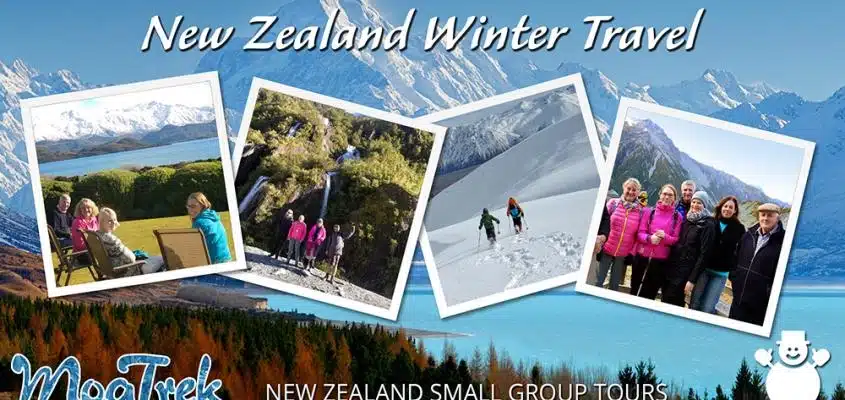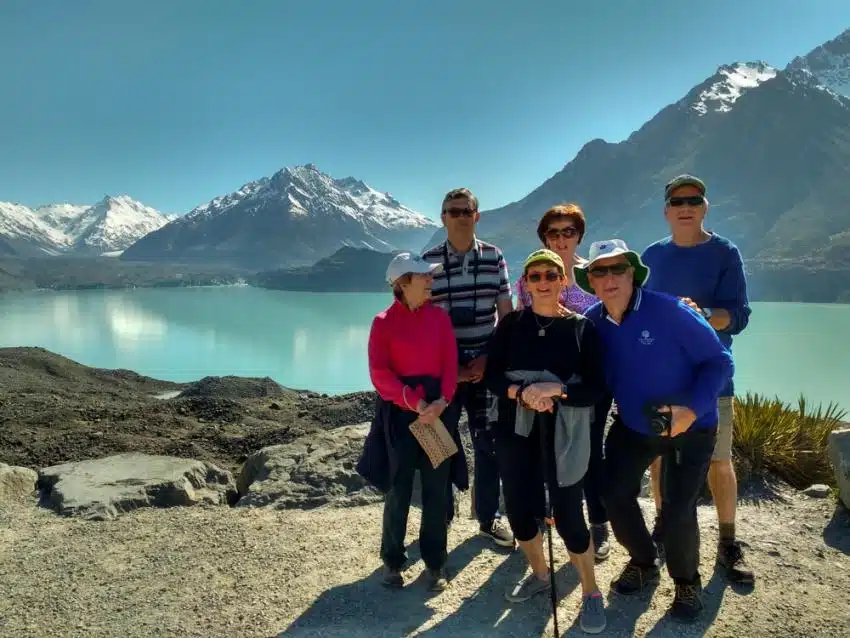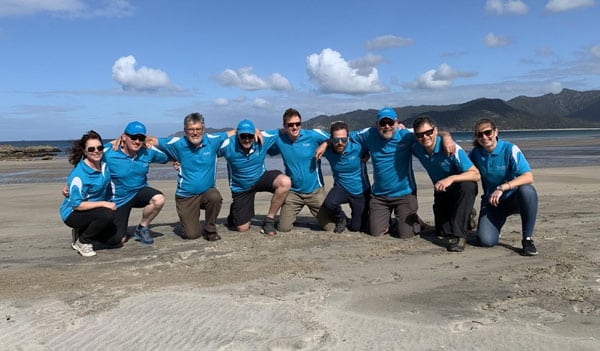Nowadays more and more people travel New Zealand during our winter months of June to September and find out for themselves all the winter fun on offer. Whether you’re looking for a winter tour or independent travel, here’s the complete guide to New Zealand winter travel, the perfect escape from the heat (or rain) of the Northern Hemisphere summer.
Does the summer heat in Europe make you run for cover? Does the August temperature in California make you long for cooler days? Sick of the great British washout known as ‘Summer’? There’s a cure for the Summertime Blues and it comes in the form of some South Pacific sub-tropical islands known as New Zealand. These islands are not only cool and welcoming during the northern hemisphere summer they are packed with winter activities and attractions for travellers. When it’s summer up north, it’s winter down under and let me tell you, winter is a great time to visit New Zealand and you’ll love the fact you can enjoy our great outdoors any time of year!
Your New Zealand winter travel experience will be awesome on so many levels.
Why Visit New Zealand in Winter Time?
When you think of New Zealand, you might imagine pristine South Pacific beaches, hikers on trails that look like the Swiss Alps, or mountain bikers crossing tracks in a forest. It’s often viewed as a summer destination. Although New Zealand doesn’t quite have the hot weather of our Australian neighbours, summers in our islands can be glorious and it’s when we see most of our international visitors. But what about winter? And when is the New Zealand winter?
Our Australian cousins know that New Zealand is a great destination for skiing. Winter sees heaps of our Aussie mates hit the best slopes in the southern hemisphere. Outside of ski towns like Queenstown and Wanaka the rest of the country is a bit quieter which means it’s a great reason to visit. Lower prices, fewer crowds, and awesome cold weather attractions make winter a great time to travel down under. It can also be a convenient time for visitors from the northern hemisphere. Summer in Europe and the US is when workers traditionally take their longest holidays or vacation time.
Why not use a couple of weeks of your summer holidays to travel to the other side of the world where you can experience New Zealand in a totally different light. The beaches are still there but so are things you can only discover when the weather gets colder.
When is winter in New Zealand?
The winter months in New Zealand are roughly June to September, just as the Northern Hemisphere is heating up.
What is the weather like in winter in New Zealand?
The weather in July (the coldest month) in New Zealand will vary depending on the latitude. It also varies thanks to the topography of the location. The far north of the country has a subtropical climate (we call it the winterless north!) while the rest of the country has a temperate climate.
Many of the towns on the South Island that lie in alpine areas can experience very cold temperatures in winter but coastal areas will be more temperate.
The average maximum and minimum temperatures for July in Auckland range from 7 and 15 degrees Celsius (44 and 59 F). In Christchurch, in the same month, the range is 2 to 11 degrees Celsius (36 to 52 F). Queenstown, which experiences quite variance in temperatures sees average max and min temperatures of 0 to 8 degrees Celsius (32 to 46 F). The award for the coldest town in New Zealand goes to Ophir in Southland, not too far from Queenstown, with the coldest temperature recorded in the last 100 years of -21.6C (-7C F). That’s cold for sure but you’ll never hear the locals complaining about it!
If you’re looking for warmer weather in July and August, then Auckland, the Bay of Plenty, and the far north are your best bets. This area is damper than other parts of the country in winter, however. Christchurch, on the other hand, is colder, but the air is drier. In general, the South Island will be dry and cold in winter. The North Island will be warmer but more damp and humid.
If you’re visiting New Zealand for skiing and snowboarding fun, August is your best bet for good quality snow. September can also be a good month but there may already be less snow on the ground. The weather will be slightly improved though, and you might get some beautiful sunny days on the slopes. July is often when the big dumps of snow arrive but this can mean the visibility is low and the ski lifts may even not operate for days at a time. July is school holiday time so if you like your slopes to be free of school kids avoid the first two weeks in July.
How much does it snow in New Zealand?
The average annual snowfall in New Zealand depends on the location. Coasts receive less snow so if you’re sticking to these areas you might not see any white stuff on the ground all winter.
Inland areas and places at higher altitudes, especially on the South Island, will usually see some snow during the months of June, July, and August. On the North Island, it’s highly unusual to see any snow in cities or coastal areas.
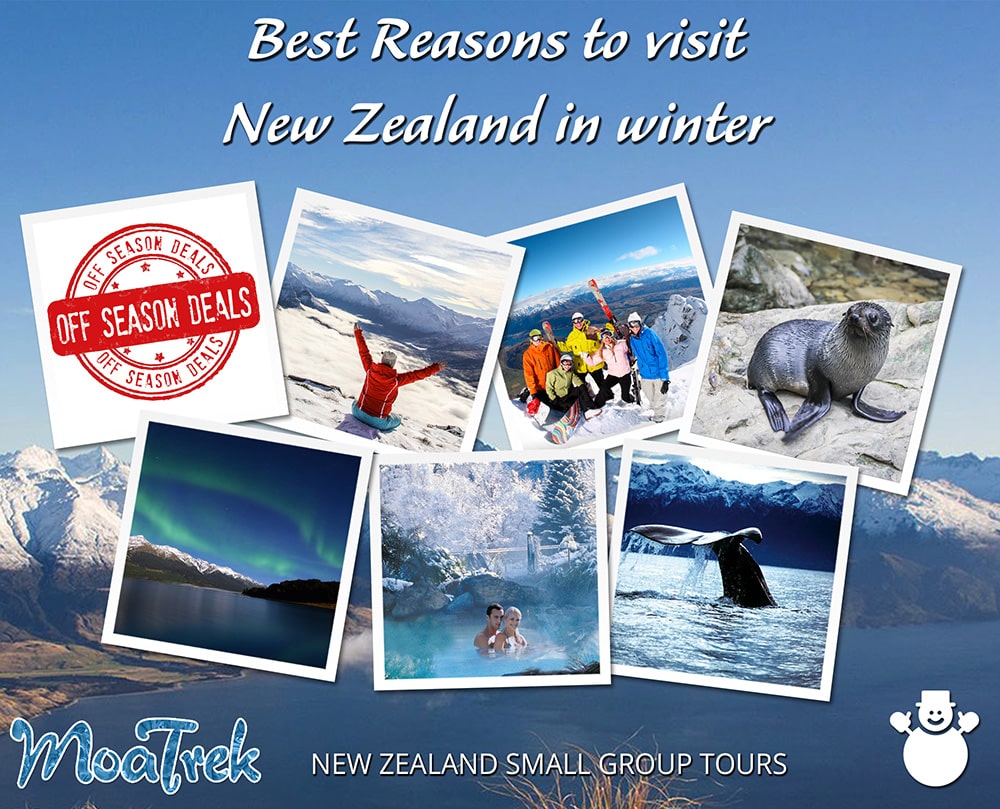
The Top 8 Reasons to visit New Zealand in winter
1. Lower prices and bargains available on accommodation, travel and events.
2. Scenery that is arguably more beautiful in winter
3. The southern hemisphere’s best skiing
4. You’ll have the place to yourself. Well, you, 4.5 million New Zealanders, and a few other travellers.
5. Baby Seals
6. Hot Springs – Much better in winter
7. The Southern Lights are a winter phenomenon.
8. Whale watching – July is the best season to see these giants of the sea
Driving in New Zealand in winter
New Zealand is a great country for driving thanks to the open roads, amazing scenery, and good driving standards. Check out our driving in New Zealand for tourists article for detailed information.
You’ll need to be a little more vigilant when driving in winter. Chains usually aren’t necessary unless you’re planning on skiing or crossing any mountainous regions between June and September. Use these websites to monitor driving conditions in winter: The Met Service and the AA’s excellent Roadwatch service. The New Zealand Transport Agency traffic info website is another good one to bookmark or even better, sign up for their email notifications while you’re here.
If you’re planning on crisscrossing the Southern Alps in winter, monitor conditions carefully and be prepared. Apart from obvious risks that come with winter road conditions, you might waste time if you come to an impassable point in the road or a road closure. Save time by doing research before setting out or even better, get someone else to do the driving.
Campervan Travel in Winter
While it’s entirely possible, using a camper van as transport and accommodation in winter in New Zealand will be tough, unless you’re fine with sleeping in cold conditions. If you do decide on camping, make sure your camper van has heating and try to camp at designated camper van sites that supply power.
Days are short in winter so know that temperatures drop and visibility reduces as early as 4 pm. The further south you go the sooner it gets dark in the winter months.
Winter driving Essentials
- Snow chains. Even if you plan on keeping to coastal areas, it’s best to have chains, just in case. The weather in New Zealand changes rapidly.
- Before taking a rental car on the road, make sure that the heater and defroster are working perfectly. Ask the rental company salesperson to show you how to fit chains to the car.
- Buy an ice-scraper for the car windows. At a pinch, a credit card will do, but you might need that card later.
- Drive more slowly in winter. Ice, black ice, frost, and other hazards make conditions for driving more challenging in winter. Adjust your driving time calculations for a slower overall pace. Enjoy the snow-capped mountains as you cruise by with your foot a little lighter on the accelerator.
Taking a tour in winter
Travel habits are changing and more and more non ski travellers are choosing wintertime to visit and see the best of the country. It’s definitely a way to see the country in a different light, and something here at MoaTrek we’ve noticed increasing in popularity over the last few years, which is why we’ve now launched our Cosy Kiwi Winter Tour from June to September. A much loved 12 day itinerary hitting all the spots you’ve heard of, Rotorua, Tongariro National Park, Abel Tasman, Mt Cook and Queenstown, plus a few little tweaks to add to the winter wonderland fun, like an overnight stay in the thermal resort of Hanmer Springs, two nights in Wellington to discover the craft beers and food scene and the chance for some skiing in Queenstown to top it all off. This tour is available as a private departure to groups of 12 or more.
If you want to see what one of our New Zealand winter tours look like, take a look at our latest winter trip pictures here.
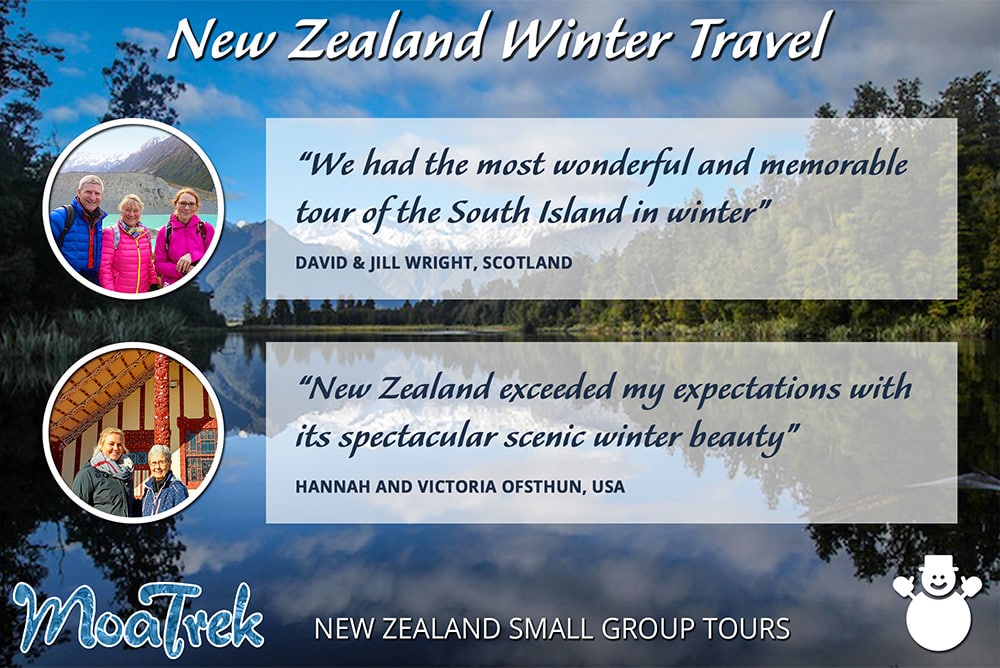
Awesome things to do in winter in New Zealand
With over 2000km (1240 miles) from top to bottom, several climate regions, and both mountains and beaches in close proximity, New Zealand offers visitors a huge array of natural attractions. Wintertime is a great time to visit as you can see and do things all over the country that you can’t at any other time of year. Here are some of the best places to visit when the temperature drops.
1. Ski or hike on an active volcano
There aren’t too many places in the world where you can say you’ve carved up the snow on the side of an active volcano. Mt Ruapehu, with its two ski fields, Whakapapa and Turoa, is the North Island’s most popular ski area. It’s also a volcanic mountain. Volcanic activity is monitored closely and thousands of people ski and hike the mountains in this area all year so there’s nothing to worry about. Whakapapa and Turoa make up New Zealand’s largest ski area and if you’re coming from Europe or the US, ski pass prices will seem very reasonable. Mt Ruapehu is 4 hours drive from both Auckland and Wellington. If hiking is your thing, you’ll love all the walks in the World Heritage Tongariro National Park, from short day walks to the full challenge of the Tongariro crossing, there’s something for all hikers.
2. Whale watching
The location of the town of Kaikoura on the east coast of the South Island was not an accident. The water near the town is teeming with plant and animal life. Fish are plentiful here. Tectonic plates collide close to the shoreline producing a very deep trench with strong currents that drag nutrients and animal life to shallow waters. Dolphins, seabirds, and whales enjoy an abundance of food in the waters off the coast. Some species of whale live year-round at Kaikoura but migrating whales, such as the humpback, blue whales, and pilot whales pass through these waters from June to August. These winter months are the best times to spot lots of different types of whales together. Try one of the specialized whale watching tours available anytime. You can even watch the whales from the sky with flights chartered specifically for whale watching.
3. Experience the Southern Hemisphere’s premier Ski destination
Ruapehu might have more terrain but the Southern Lakes’ neighbouring ski fields of Treble Cone, Cardrona, The Remarkables, and Coronet Peak near Queenstown offer something for everyone and scenery like you won’t believe. When visitors come to New Zealand for the skiing, this is where they come. You’ll find a mix of Kiwis, Aussies and international visitors skiing, snowboarding and having all kinds of fun around Queenstown and Wanaka from June to September.
One of the best parts about winter sports in this part of the country are the views. The Southern Alps are spectacular at any time of year but when you’re zipping down the slopes on skis, the snow-capped mountains all around look truly spectacular.
Queenstown, the base for most skiers, is an awesome base for a winter family holiday. The kids will love it and there is plenty of après-ski options for the parents. When bad weather forces the ski fields to close, the towns of Queenstown and Wanaka have no shortage of things to do.
The Queenstown-Wanaka area isn’t the only place to ski on the South Island either. All along the spine of the island, from Nelson Lakes to Queenstown, wherever the Alps reach over 1000 metres, you can find large and small ski fields to suit every taste. Mount Hutt is the South Island’s largest skifield, is 2 hours from Christchurch and for a real local flavour try the club fields like Porters, Broken River, Mt. Cheeseman and Temple Basin in the Arthur’s Pass area.
4. Hot Pools
Who doesn’t love a dip in a hot pool or tub on a chilly day?
Hanmer Springs is a complex of hot pools, thermal baths, and spas about 100km north of Christchurch and 100km west of Kaikoura. Open every day, the naturally heated thermal pools are especially nice to relax in when the weather is cold. The pools never shut, even when it rains. The water in the pools contains minerals and other properties that promote health and wellbeing. There’s only one way to find out if that’s true!
Another option is the Onsen Hot Pools near Queenstown. Overlooking the Shotover river, where so many adventure activities take place, the hot tubs in the Onsen facility are the ultimate relaxation and pampering option. After a few days hiking in the hills or carving up snow on the slopes, there’s nothing better than to soak your muscles in a hot tub and enjoy a magnificent view down below.
5. Southern Lights
I’ll bet you’ve heard of the Northern Lights. But down south we don’t like to be outdone. We have our own lights, called the Aurora Australis. From March to September you’ll have a chance to catch the light show if you’re far enough south. The bottom part of the South Island is your best bet. The Catlins near Invercargill is not only a wonderful place to visit, even in winter, but is one of the prime locations to see the Southern Lights. Check this website for forecasts. You’ll be glad you did.
6. Glacier Hiking
If you visit glaciers in most places on this planet, you’ll need to wrap up warm. New Zealand’s glaciers lie in relatively warm zones and are unique in that two glaciers lie almost at sea level.
Winter is a good time to visit Franz Josef Glacier and Fox Glacier on the west coast. The weather is less turbulent and conditions can actually be drier than during the rest of the year. Another reason for visiting in winter is that you’ll share the ice with fewer people. The glaciers are ‘open’ all year. The only time guides won’t go up is during storms and if conditions are dangerous.
At this time of year, the glacier features appear different to the summer months when the warm weather melts the ice faster.
7. Star Gazing
Mt John near Lake Tekapo is one of the most important night sky spots in the country and draws plenty of international visitors. In fact, the Mt John observatory is a huge draw for visitors from all over the world as it’s one of only three Gold Standard International Dark Sky Reserves in the world. To experience the Aoraki Mackenzie International Dark Sky reserve you need to spend a night in either Tekapo, Twizel or Mt Cook village. Winter is a particularly good time for night viewing or star gazing. If photography and film-making are your thing, pick a clear, crisp night and set up some time-lapse photography to capture the skies over New Zealand from a superb vantage point. Low pollution and light levels in this part of the world means that the stars are even brighter. The long nights in winter give you a good window of opportunity for getting the best shots or simply enjoying the beauty of the southern skies.
The surrounding Mackenzie country is also one of the most beautiful places in the entire country. Visiting in the winter months will give you the chance to experience a different shade of the high country lakes amazing blue/green lake colours with a backdrop of the snowy Southern Alps.
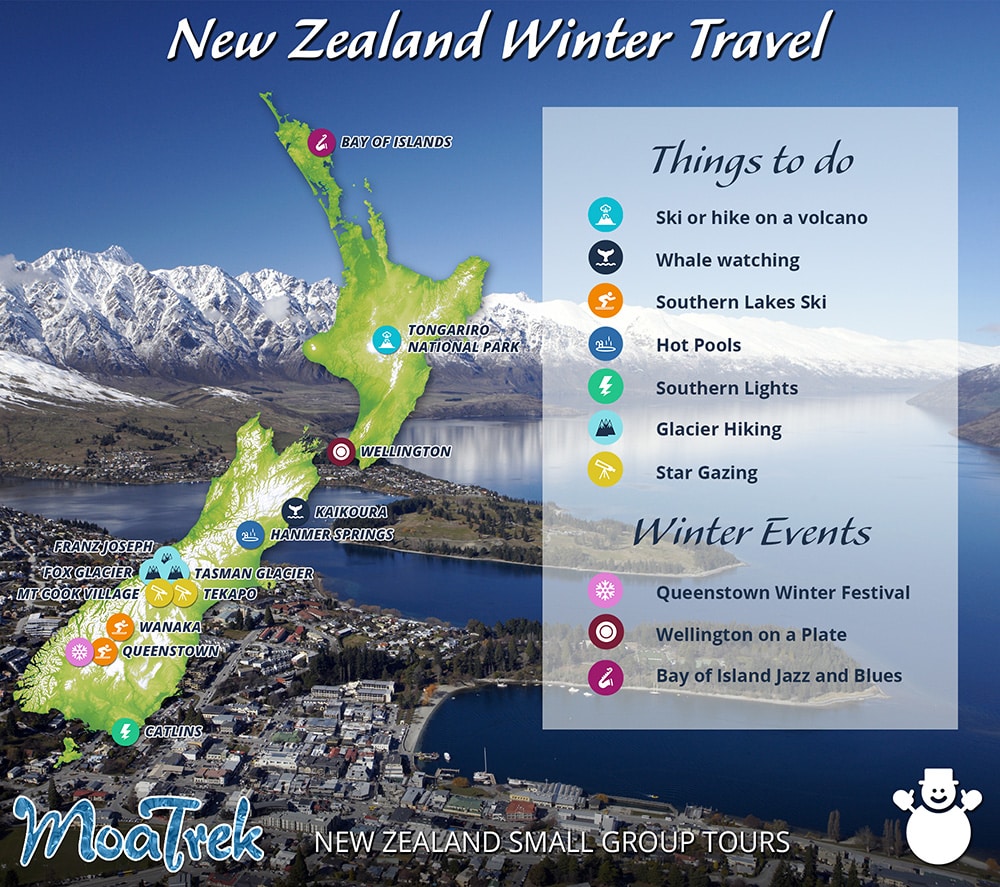
New Zealand Winter Event Recommendations
What to do in June, July and August in New Zealand
1. The Queenstown Winter Festival
The festival takes place in June each year so if you can why not time it to enjoy one of New Zealand’s most fun festivals? The Queenstown Winter Festival is a weekend of themed races, musical events, food, fireworks, and night skiing. There’s something for everyone here and you’ll never be short of some entertainment. Book your accommodation well in advance as the Winter Festival is very popular with Kiwis and international visitors.
2. Wellington on a Plate
Check out the Wellington On A Plate Festival and try the best of New Zealand food in one place. The festival is in August and every day you’ll find exclusive menus, pop-up restaurants, cookery classes, and tasting events as restaurants, cafes, and bars in the city showcase regional foods from the entire country. It’s a must-see event for foodies.
Wellington is a great city for coffee culture and dining and this once a year event is the icing on the cake.
3. Bay of Islands Jazz and Blues Festival
Jazz, Wine, and the warm (warmer than the rest of the country at least) climate of the beautiful Bay of Islands come together in August every year.
The Bay of Islands are a major tourist destination in New Zealand thanks to the fantastic scenery, sailing, fishing, and relaxed way of life. Combine the Jazz festival with some wine tasting and a cruise around the bay.
The entrance price for the Jazz Festival is a very reasonable $60 for 3 days. If you’re travelling down south from Auckland at this time of year and love jazz, why not add a few extra days to your adventure with a short trip north for the festival beforehand?
Hiking in New Zealand in Winter
New Zealand’s Great Walks are a series of multi-day hikes with varying levels of difficulty. Of New Zealand’s nine Great Walks, five are located on the South Island (the other four are on the North Island and Steward Island). The Milford Track is possibly the most famous of all the great walks and it’s easy to see why. Walking the track in Milford feels like you’ve entered a new world.
Tramping in winter, however, is a lot harder than in summer when the Great Walks season is open (from October to May). Reduced facilities, snow, and other hazards make the journey a lot more challenging and tracks like the Milford and Routeburn are recommended for experienced hikers only in winter.
But that doesn’t mean you can’t get out and walk the hills in winter. Use caution at all times but especially in winter when the weather can change dramatically in minutes. Here’s a quick summary of some of our favourite short walks in winter which can be accessed easily and you can be back having a mulled wine by the fire right afterwards:
Tongariro Day Walks
If you’re staying in the Chateau Tongariro there are some great short walks right out your door, like the Taranaki Falls or Silica Rapids track. There walks are accessible in winter without special equipment and will give you a great experience of the volcanic landscape.
Abel Tasman National Park
Even in wintertime you can still walk on the golden sand beaches of the Abel Tasman, you might even be brave enough to go for a swim! Abel Tasman is low lying and located right in the heart of the sunniest area of New Zealand, it’s very unusual to see snow here. The national park is really easy to get to for the day from Nelson, or closer. You can jump on a water taxi and take your pick from day walks from 2 – 6 hours.
Mount Cook National Park
Similar in a sense to staying at the Chateau Tongariro, when you’re in the Hermitage Hotel at Mt Cook you’re right in the heart of a World Heritage national park with awesome tracks right out your door. The big difference here is that you’re looking right up at the highest peaks in the Southern Alps, including of course Aoraki Mt Cook. The glacial landscape is all around above and around you. Our favourite Mt Cook winter walks are the Kea Point track and the Hooker Valley, super scenic, great tracks and really easy to get to.
Queenstown winter walks
Being a ski resort, the temperatures do drop here in winter, but the town itself is not covered in snow all winter, in fact, snowfalls right down to town level are quite rare and celebrated events. This is great for walkers, as Queenstown has an array of tracks close to town which are really easy to get to (no car required for many of them) and the snow on the mountains and crisp winter air add to the exuberance. Our favourites are the Queenstown Hill Time Walk, Queenstown Gardens and Frankton Arm track and the Ben Lomond walk from the top of the Gondola.
See more about our favourite New Zealand short walks here, most of which are accessible all year round.
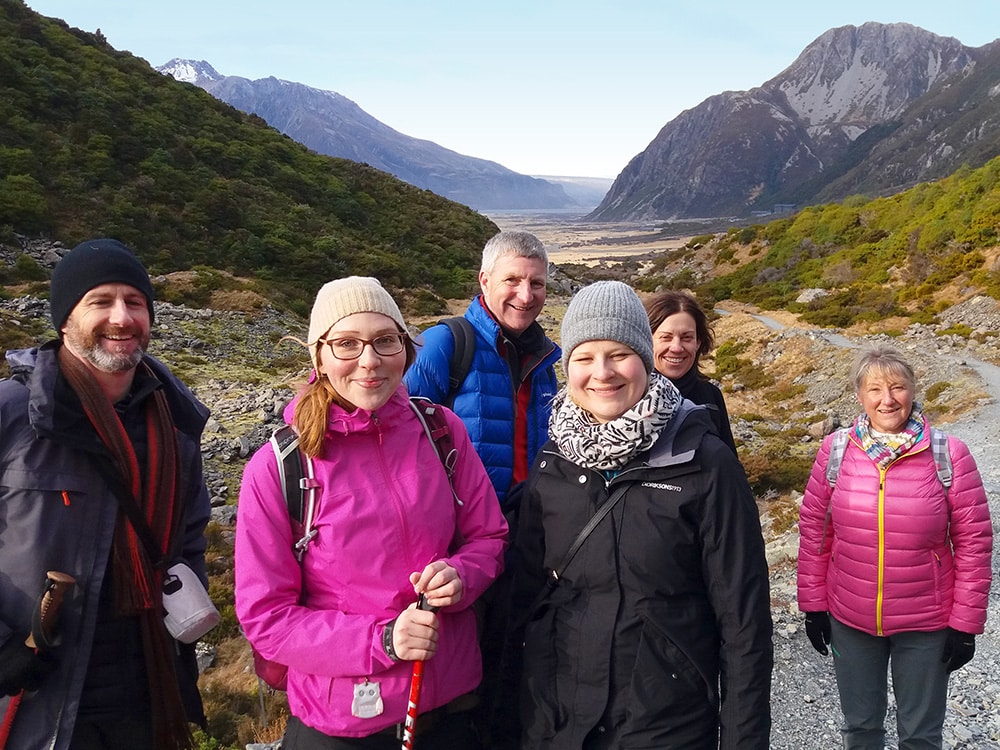
Accommodation in Winter
Most of New Zealand’s overseas visitors arrive in the summer months (roughly November to March). Fewer people arrive in the winter months of June, July and August. Outside of the ski towns that means lower prices for accommodation and a great opportunity to check for deals on activities and tours.
What to pack for winter travel to New Zealand
Visitors from the UK, Western Europe or the Pacific Northwest can expect similar winter conditions in New Zealand. Bring the same jackets, hats, gloves, and warm clothing that you would use for travel in the UK, Europe or North East of the USA from December to March. If you plan on hiking in winter, you’ll need sturdy waterproof boots and some extra layers of clothing.
Kiwis are outdoor types and there are stores in most towns that cater to the outdoor enthusiast. If you’ve forgotten anything you can certainly find a replacement down here. Even if you’ve brought everything you need it’s worth checking out Merino wool clothing, a New Zealand speciality. Lightweight, warm, and comfortable, Merino wool is a great fibre for outdoor apparel. Chances are you’ll fall in love with it while you’re here and a few extra Merino items will find their way home with you!
Packing List for Winter Travel in NZ
• Warm jacket or fleece
• Waterproof and windproof jacket
• Gloves
• Beanie or warm hat (For all you Canadians out there, this is your Tuke!)
• Waterproof boots/shoes for hiking/wet weather
• Lightweight, breathable long-sleeved shirts and pullovers – Merino wool is ideal
• Hiking pants with shorts zip-offs – It can get hot in winter too
• Swim trunks / Bathing costume – You don’t want to miss out on the hot pools.
• Sunglasses – The New Zealand sun shines bright in winter
• Wide-brimmed hat or baseball cap
• Thermals – For hiking, camping, and skiing
Visit New Zealand in Winter
It might be a cliché that Kiwis are friendly. But come in winter and you’ll feel even more welcome. With fewer tourists around the locals have more time to chat and you’ll find yourself making friends in every town.
If you’ve been to New Zealand before we’d recommend experiencing the country in winter when, despite the beaches being less inviting, there are plenty of other amazing things to see and do. So if you’d like to find out more about what winter travel in New Zealand is like, get in touch now, we’d love to chat!


